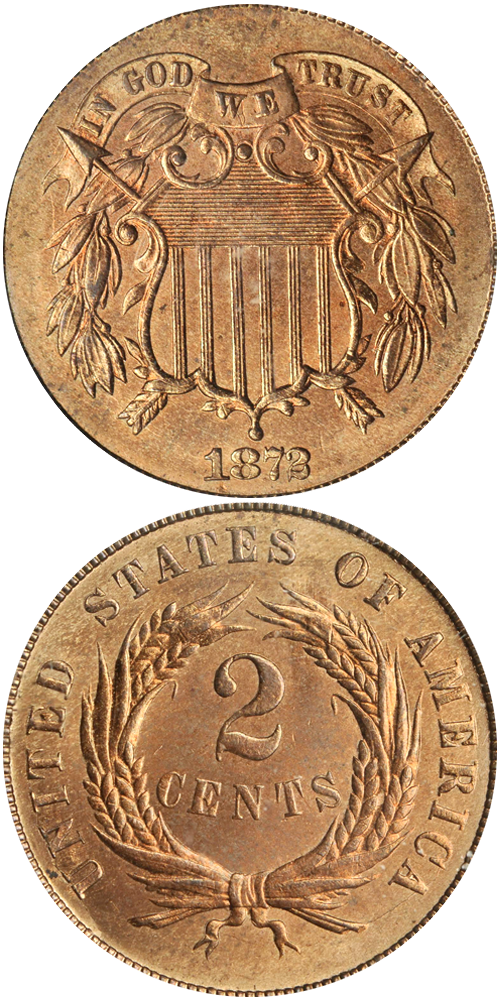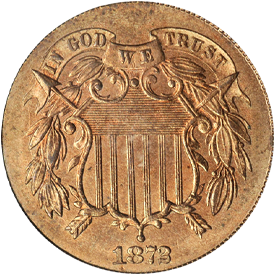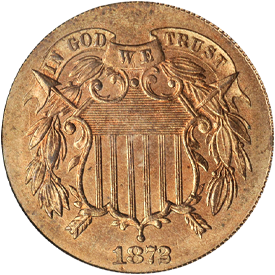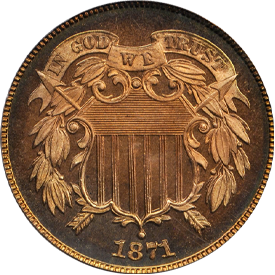Designed by: James B. Longacre
Issue Dates: 1864-1873
Composition: Bronze (95% copper, 5% tin and zinc)
Diameter: 23 mm.
Weight: 6.22 grams (96 grains)
Edge: Plain
Business Strike Mintage: 45,601,000
Proof Mintage: 7,500 (estimated)
The two-cent piece, made in pattern form as early as 1836, was first used in circulation in 1864. The obverse design depicts a shield with two arrows behind, a wreath surrounding, and the motto IN GOD WE TRUST (the first U.S. coin to display this motto) on a ribbon above. The date is near the bottom border. The reverse illustrates an open wreath enclosing the denomination 2 CENTS, with UNITED STATES OF AMERICA around the border.
Intended to alleviate the coin shortage of the Civil War era and to provide for a convenient substitution for two individual cents, the two-cent piece was minted in large quantities during the first two years of its existence, after which the mintage figures declined, until in 1873 the mintage was limited just to Proofs for collectors.
Specimens of early years, particularly 1864 through 1869, are readily available in any grade desired from Good through AU. Uncirculated pieces are scarce, and superb Uncirculated pieces with full original mint color are quite elusive. Rarities in the series include the 1864 Small Motto, the 1869/8 overdate, and the Proof-only 1873.
Further Reading
Two-cent pieces, a short-lived series, were issued from 1864 through 1873. Exactly why a piece of this denomination was considered necessary in our decimal coinage system is not known. The suspension of specie payments (silver and gold coins) had severely restricted circulating coinage, and perhaps the two-cent piece was intended to help alleviate this.
The idea of a two-cent piece dates back many years earlier. Documents in the National Archives reveal that on December 12, 1836 the director of the Mint, Robert M. Patterson, proposed that a two cent piece be coined. Early in 1836 Christian Gobrecht, who was to gain fame for his illustrious silver dollars of the 1836-1839 period, prepared patterns of this denomination. These two-cent patterns, rare today, featured a small eagle with wings spread standing on a cloud, a design not too much different from that used decades earlier on the so-called Small Eagle reverse silver coins (1796 quarter dollars for example). The reverse of the piece was simple and bore the denomination within a wreath.
Despite the fact that patterns were made in several different metal compositions and varieties, the idea went no further than the Mint. Two-cent pieces were all but forgotten.
In 1863 the denomination reared its head again. Several different pattern issues were prepared, pieces entirely unlike those made in 1836. The 1863 pattern two-cent pieces were of the size regularly adopted in 1864. Several different 1863 issues featured the head of President George Washington. Mottos on the pieces included GOD AND OUR COUNTRY, GOD OUR TRUST, and the finally adopted IN GOD WE TRUST.
In December 1863, Mint director James Pollock wrote to the secretary of the Treasury as follows, in part: "I also propose for your consideration the coinage of a two-cent piece, same material and double weight of the cent, and with such devices and mottos as may be approved by you. The piece would be a great public convenience, and its coinage, in my opinion, should be authorized. The devices are beautiful and appropriate, and the motto on each coin, as all who fear God and love their country will approve. I prefer the 'shield and arrows' to the 'head of Washington' on the obverse of the coin. They are submitted for your consideration."
In 1864 the first regular issue two-cent pieces made their appearance. Each bore the IN GOD WE TRUST inscription, the first appearance of the motto on any circulating United States piece. Two varieties exist for the year 1864: the so-called Small Motto issue and the Large Motto variety. The Small Motto coins are scarce in all grades and are great rarities in Proof.
Great things were expected for the two-cent denomination, and in the first year, 1864, nearly 20 million pieces were coined. Enthusiasm and public acceptance waned, and in 1865 the mintage dropped sharply to just below 14 million pieces. The following year the mintage plummeted further to 3 million pieces. Production quantities drifted downward to the point at which only 65,000 were struck in 1872, the last time pieces were made for general circulation. The two-cent denomination was, for all practical purposes, dead.
There remained one final gasp, however. In 1873 approximately 600 specimens were made in Proof condition as part of sets distributed to collectors that year. These have the closed 3 numeral, with the upper and lower knobs on the digit close together. At a casual glance the 3 resembled an 8, so the open 3 variety was later made. Apparently 500 or so of the latter style were produced, perhaps later in 1873 or a few years after that time. Harry X. Boosel has specialized in the study of 1873 coin varieties and first publicized the open and closed 3 issues to numismatists through a series of articles in the Numismatic Scrapbook Magazine years ago.
Between the first year of issue, 1864, and the last, 1873, there are several varieties of interest to the specialist. One has been designated as an overdate, "1865/4," but some believe it simply to be a recutting, not an overdating, of the last digit. A variety of 1867 has the letters composing IN GOD WE TRUST sharply doubled, similar to the 1955 Doubled Die cent variety. These are quite scarce. Very rare is the 1869/8 overdate. Over the past several decades I have seen only a half-dozen or so pieces, including the Uncirculated example in our Austin Collection sale. The rarity of 1869/8 is explained by what probably was a short-lived die. All known specimens have a prominent die break by the date and extending to the border.
Proofs were issued each year from 1864 through 1873. As noted, the 1864 Small Motto variety is a rarity in Proof condition. It is believed that fewer than two dozen exist. Proof 1873 two-cent pieces, while not particularly more elusive than Proofs of certain earlier dates, have a special significance as they are Proof-only issues; that is, no pieces were struck for general circulation. As such, completion of a date set of two-cent pieces requires that a Proof be obtained. This has placed an additional demand over the years on the supply of these coins.
As is the case with Indian cents, two-cent pieces in Uncirculated and Proof are often apt to be less than expected once they are examined closely. All too many "Uncirculated" pieces are simply Extremely Fine or AU coins that have been cleaned to a bright orange color. True Uncirculated pieces with full mint color are quite scarce, even for the high mintage dates of 1864 and 1865. Nearly always such pieces with full original color have some flyspecks or microscopic spots.
In Coin World, issue of May 23, 1973, I wrote a detailed article on two-cent pieces. I discussed how numerous coins had been cleaned and noted that "the time evidently is not too far distant when a truly brilliant Uncirculated (as opposed to a cleaned example) two-cent piece of any date will touch the $100 mark and a Proof will be worth more than $200." Readers of that story who owned or made purchases of such pieces were to see their value multiply by more than 10 times in subsequent years!
"The more things change, the more they are the same." Hence, numismatists had a wry smile when they read a few years ago of an effort in Congress to propose a new denomination: the two-cent piece. The advantage, it was said, was that a two-cent piece would alleviate the production demands made for Lincoln cents. Further, it would simplify transactions in everyday commerce. It was not recorded in the article I read whether or not the "lessons of history" were part of the Congressional debate. As it turned out, the short-lived anticipated revival of the denomination came to naught.
While two-cent pieces are collected by dates by a number of specialists, some of whom identify specific die varieties using a monograph, The Two-Cent Piece and Varieties, by Mike Kliman (published in 1977), by far the greatest demand comes from numismatists seeking but a single example of the 1864-1873 years for inclusion in a representative type set of United States coinage designs.









